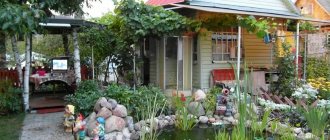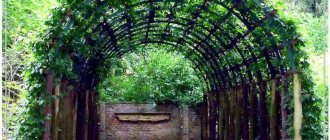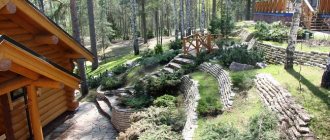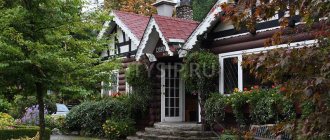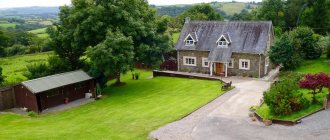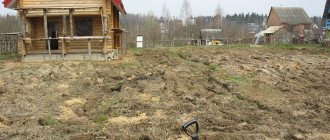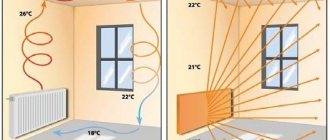- Irrigation system at the dacha: a variety of options for irrigating plants
- Types of irrigation systems for gardens and cottages
- Subsurface irrigation system for greenhouses
- Rain garden watering system: features of the option
- Operating principle and distinctive features of drip irrigation
- Irrigation system at the dacha depending on water supply
- Selection of pipe material for irrigation in the country, product characteristics
- How to do watering at the dacha with your own hands: main points
- Installation of watering and irrigation systems for a summer residence
- Video: how to make drip irrigation at the dacha
Location of the automatic watering system on the site
Each site has its own characteristics. Different plants also require different types of watering. When organizing irrigation at your dacha, you need to take all these points into account, but in general, you can set up an irrigation system on any site. Suitable for flower beds, vegetable gardens and ordinary lawns.
The main thing: you need to organize the system so that water gets evenly to all the right places. Some areas should not be allowed to become overly flooded and others to dry out.
Before starting work on installing the structure, you need to draw a plan of the entire site, mark the buildings and plant locations on it. After installation of the system, control runs are carried out and the irrigation radius is monitored.
If water does not reach some areas, the arrangement of the elements is changed. This is how the final optimal option for arranging the parts of the irrigation system is selected.
In various photos of automatic irrigation systems, you can see examples of the location of sprayers in the garden.
Operating principle and distinctive features of drip irrigation
Do-it-yourself drip irrigation at the dacha is the most economical and rational irrigation option. The principle of operation of the system is based on the flow of water in small portions directly to the roots of the plant through a drip tape connected to an irrigation pipe. This option is possible when supplying water to the central water supply for irrigation in the country. If it is served by the clock, then moisturizing will occur in the same way.
Such irrigation can be carried out from a storage tank for irrigation at the dacha if there is no water in the main pipeline. This option will ensure round-the-clock irrigation of the soil.
Drip irrigation is one of the popular methods of irrigating flower beds and greenhouses.
This method of watering does not interfere with air access to the roots of the plant and does not contribute to the deterioration of the soil structure. In this case, you can avoid drying out or flooding the soil and refuse to regularly loosen the soil. The main disadvantage of such an irrigation system is the high probability of pipe clogging, which occurs as a result of small debris and soil particles entering its cavity. Therefore, the system needs periodic cleaning.
This type of watering can be done using drip tape, a rigid hose with small holes, or small-diameter plastic pipes. The elements are laid along the bed with plants and connected to a common pipe. To organize watering of several rows, a splitter is mounted, which is located at the beginning of the bed. It promotes uniform distribution of tape segments. The tape is laid in a spiral around the tree trunk. Plastic pipes are usually installed along permanent beds. Holes are first made in them using a hot awl.
Types of automatic watering systems
The irrigation system is chosen depending on what requires irrigation: vegetables in a summer cottage, fruit trees and shrubs, or just a lawn in front of the house.
Types of automatic watering systems:
- Sprinkler
- Drip.
- Subsurface irrigation.
Let's consider the features of these systems and their applications.
What types of sprinkler devices are there?
High-quality and efficient soil irrigation systems based on the sprinkling principle require the selection of special installations, which come in three types: statistical and pulse or rotary, divided according to the method of operation.
When making a selection, such indicators as the intensity of spraying and the area of the treated area are taken into account; different devices guarantee the formation of different water flows, are easily adjusted and allow automated use with the adjustment of functional parameters.
Sprinkler system
Sprinkler irrigation is the best option for watering your garden and lawn. Advantages of a sprinkler irrigation system:
- possibility of pressure adjustment;
- harmonious integration of elements into landscape design;
- simultaneous irrigation of soil and plant foliage.
The main component of the system is a sprinkler, also known as a water sprayer.
Rotary sprinklers irrigate an area within a radius of up to 30 m. Also, thanks to a moving head, they can change the angle of water supply.
For lawns, retractable sprinklers are produced; they appear above the surface only during operation, and then hide back.
Fan (pulse) sprinklers supply water at regular intervals. They cover an area with a radius of 18 m. Water is supplied in only one direction.
Surface irrigation: methods and possibilities
The simplest system of organizing irrigation, based on the principle of natural absorption of moisture by the soil, there are three options for organizing such artificial watering of the soil, which are fundamentally different in the method of water supply.
The most ineffective irrigation of a site is considered to be flooding, which is characterized by maximum consumption of valuable water resources and the possibility of damage to the root system of plants due to waterlogging of the upper, soil layer.
Drip system
Drip irrigation is used in vegetable gardens and greenhouses. With drip irrigation, only the root zone of plants is moistened, since water is supplied pointwise.
Advantages:
- saving water. The soil is moistened only near the roots;
- water does not get on the leaves. On a sunny day, water on the leaves can cause the plant to burn;
- Possibility of adjusting water pressure.
When laying a drip system, the water supply pipe should pass close to the plants - at a distance of 20-40 cm. In relatively narrow beds, one pipe is installed between 2 rows of plants.
Subsoil irrigation
When installing such automatic watering, pipes are laid underground and water is supplied directly to the roots. The pipes are dug to a depth of 20-30 cm. This is done simultaneously with planting the plants.
The distance between the two supply pipelines is 40-90 cm, and the distance between the water supply holes located on the pipe is 40 cm.
Basically, the subsurface irrigation system is used in greenhouses for growing crops on an industrial scale and in botanical gardens.
Instructions for using the device
It is recommended to assemble the system in the fall, after the plantings have withered, or in the spring, when flowering has not yet begun. After completing the installation work, all that remains is to operate the system correctly.
Having launched it, it is necessary to check the pipes for leaks, configure and conduct a global check of the functionality of the SAP.
Operating procedure for drip-type SAP:
- Install the pump and its piping.
- Install the storage tank piping.
- Place plugs on the hoses.
- Check the filter operation and wash it.
- Open the tap through which water is supplied to the pipes/hoses or to the container (wait for it to fill).
- Test the automatic float valve that limits the water level in the container. Change it if necessary.
- Connect power to the pump. The latter will turn on and off automatically. Check pump pressure.
- Ensure operating pressure is supplied to the SAP. Inspect all connections for leaks.
- Turn on the power supply to the control panel.
- Insert the battery into the remote control if necessary.
- Turn on the remote control. Enter the watering program using the instructions in the instructions.
- Launch SAP and check its operation and the settings of sprinklers on all irrigation lines. Adjust the operation of each sprinkler element manually or using a key. Wash the sprinkler filters.
- Test drip lines and each water point. Find out how tight the system is.
- Start auto mode - set to Run.
When operating systems, it is important to handle them correctly and know how to properly provide plants with water using them.
What you need to know about irrigation with SAP:
- if the grass cover has faded, the lawn needs to be watered after 2-3 days of drought in the summer and after 5 days in the spring;
- It is better to water in cool weather, early in the morning and late in the evening - water is effectively absorbed into the soil without evaporating;
- watering lawns should be done to a depth of 15-20 cm;
- You can’t water lawns every day - this will lead to rotting of the roots;
- watering rate - 5-12 liters per 1 sq. m;
- to reduce water consumption rates by 50%, it is recommended to use absorbents;
- the flow of water should be slow.
The principle of operation of automatic watering
First, of course, you need a source of water. A pump is connected to it, which will pump water into the system. A liquid distribution unit is connected to the pump.
Pipes are connected to the block, through which water is supplied under pressure to the sprayers. Filters are installed at the beginning of the chain so that contaminants that may be in the water do not clog the system.
Sensors are also installed, which are responsible for automating the entire process. A programmer is connected to the liquid distribution unit.
It is this computerized controller that controls the garden watering system. The controller programs the time at which the sensors should open the valves to supply water.
Pros and cons of automatic watering
The organization of SAP requires considerable investment. Their installation requires the services of professionals, and their operation requires compliance with certain rules and regulations.
Advantages:
- it is possible to control the system - set the frequency and intensity of watering;
- you can set watering hours by zone of the site;
- saving time and effort;
- rational use of water;
- the possibility of a long absence from the site without damage to plants;
- the system turns off if it starts to rain;
- thoughtful placement of automatic watering circuits allows you to water the most inaccessible places;
- the device responds to changes in humidity;
- long term use.
Flaws:
- serious financial investments;
- require regular maintenance;
- for different types of plantings it is necessary to establish individual irrigation regimes;
- the services of a mechanic and electrician are required - if the owner of the site does not have skills in plumbing and electrical work;
- constant operation of the plumbing system is required.
Design and installation
Regardless of the choice of automatic irrigation system, it is important to correctly install all its elements.
When designing, you need to carefully consider where to place the water sprayers so that you don’t have to manually water forgotten areas later.
How to water yourself? Let's look at each design stage in detail.
Development of a watering system diagram
In order not to make mistakes during development and not forget anything, you need to draw a site plan. The plan should indicate the source of water, buildings and green spaces.
For the plan, choose a scale, for example, 1 meter of plot = 1 cm on the plan. The desired irrigation zones are then marked on the plan.
Next, draw the lines along which the water pipes will be laid. For rain irrigation, the radius of action of the sprayers is indicated on the plan. And when installed, the sprayers are placed relative to each other at a distance from their radius of action.In addition, you need to take into account that tall bushes and trees will retain water, so additional sprinklers are installed to water the plants behind them.
Preparatory stages
To begin installing the irrigation structure, the following preparatory steps are performed:
- Draw up a project
- Calculate the cost
- Install
- Launch
At the design stage, you need to draw up a plan of the entire area where irrigation is planned. The diagram is also called a dendroplane, on which all plants are marked. The area of the site is measured with a tape measure and a plan with paths, buildings and plants is drawn on a piece of paper.
Preliminary plan for an automatic watering system Source www.termoclick.ru
Project calculation
A specialist will help you perform all the necessary calculations for an automatic garden watering project. You need to calculate:
- site watering rate;
- volume of water tank;
- pump parameters;
- diameter of main pipes and tubes inside zones.
If you have knowledge of hydromechanics, you can carry out the calculations yourself, but it is better to turn to professionals, especially if the territory is large.
Criterias of choice
If the owner of a personal plot is going to install SAP, he can choose a ready-made complex. Craftsmen who prefer to do everything with their own hands can develop the system themselves, but this path is much more complicated and takes a lot of time - it’s easier to buy a ready-made complex.
SAP selection criteria:
- Type of irrigation system. Based on the operating principle, the following types of SAP are distinguished: drip and microdrop;
- sprinklers;
- fogging;
- basal;
- subsoil.
When choosing, you need to take into account what types of plants will have to be watered and how far away the watering objects are from the water intake point.
Selection of sprinklers
For individual planting areas in low parts of the site, drip irrigation is the best choice. But the lines for rain and drip irrigation must be separate. Different types of sprayers cannot be installed on the same line.
Different types of sprayers require different system pressures, so you won't be able to adjust the pressure in such an uneven line.
Determining the amount of water flowing through an irrigation system
Now you need to find out what is the maximum number of simultaneously operating sprinklers on your site. This also determines the operation of the irrigation canals in the system: whether they can function simultaneously or whether they will need to be launched one after another.
In order to find out the throughput, you will need a hose 1 m long and 19 mm in diameter. You need to record in seconds how long it takes for this hose to fill a ten-liter bucket of water. After this, we calculate the distance directly from the tap itself to the distant sprinkler so that after 15 meters we add another 2 seconds to the total time.
All obtained values must be added together and compared with the table included with the irrigation systems. This way you can determine the permissible number of sprinklers.
Necessary materials
If you are knowledgeable about plumbing and electrical installations, you can install automatic irrigation yourself. The following materials and equipment will be required:
- pump;
- programmable controller;
- wires and corrugated pipe to protect them;
- plastic pipes;
- fittings, tees, valves;
- sprinklers (sprayers).
The installation of pipes is carried out in accordance with the lines that were drawn on the plan.
Pipe laying
Pipes are laid on the ground or underground. The option of laying on the ground is a summer option for watering the garden plot. This structure is dismantled for the winter.
When installing a permanent automatic irrigation system, a trench with a depth of 30 cm is dug to lay the pipeline.
For the main center line, choose a larger diameter pipe. Thinner pipes are connected to it. They use polymer pipes that are not susceptible to rust. Before burying the pipeline, a working test is carried out.
It is also necessary to install a valve to reduce pressure; it will be needed to drain water when preparing the line for winter. The valve is installed in the drainage well.
To save water, install a sensor that detects soil moisture. During rain, such a sensor will block the start of irrigation.
Selection of pipe material for irrigation in the country, product characteristics
Before organizing irrigation at your dacha, you should decide on the material of the pipelines for the selected irrigation system. Metal products are characterized by strength, reliability, durability and affordable cost. Among the negative factors are the high cost of shaped connections and shut-off valves, the susceptibility of products to corrosion, and the complexity of installation, which requires special skills and abilities.
The quality of pipes and materials is the key to long-term service of the irrigation system.
Plastic products are more modern, practical and inexpensive. The walls of the pipes are extremely smooth, so that deposits will not accumulate inside the pipelines, which eliminates a decrease in the throughput of the product. The material is characterized by strength and durability.
HDPE pipes for irrigation in the countryside do not respond to temperature fluctuations or exposure to aggressive environments, and can be used for above-ground and underground installation. The connection of PVC system elements is carried out using glue, mastic and structural fittings - this can be done independently, without having special skills.
Among the most popular manufacturers of polyethylene pipes are the companies Rehau, Wavin and Ostendorf, which produce high-quality products with high technical and operational characteristics. The price of pipes for irrigation at the dacha is 50-90 rubles/m.
By choosing pipes produced by well-known brands, you can be confident in the quality and durability of the products.
The most durable and flexible are polyethylene pipes, which do not burst when water freezes. The most optimal option is considered to be a product diameter of 20-40 mm. The system elements are connected using the soldering method. Polypropylene pipes are a more economical option. They have increased strength and durability. Individual sections are connected by soldering joints or fastening with couplings. You can buy pipes from well-known manufacturers Rehau, Aquatherm, Banninger, Wefatherm, Ekoplastik, Valtek, Pilsa, Pro Aqua, Santrade for 30-60 rubles/m.
Installation of connecting elements
Polymer pipes are fastened together with compression fittings. It is at the connections that leaks can appear over time. Therefore, all tees and taps are mounted in hatches for ease of access.
Such a hatch is not buried in the ground in order to provide quick access to the connections in case of need for repairs. A separate tap is installed for each individual line.Winter protection
To prevent the automatic irrigation system from deteriorating when frost sets in, the water from it is completely drained before the onset of real cold weather. To do this, use a pressure reduction valve.
All threaded connections that are above the ground are disconnected and stored for the winter. If you do not want to dismantle the sprayers and drippers for the winter, then the system must be purged after draining the water.
Purge operating pressure up to 6 bar. By completing these measures, you can be sure that when spring comes, your automatic watering system will be in working order.
The cost of installing an automatic irrigation system will pay for itself by saving water and your time. Automatic watering is targeted and adjusted according to the desired schedule. Such a garden watering system will allow you to free up a lot of time for other activities and just relaxation.
How to water plants correctly
In addition to the correct selection of the type of watering and its proper organization, it is necessary to follow basic rules that will make moisturizing as beneficial as possible:
- The main rule is that any watering must be systematic. In other words, it should not depend on either the month or the hours of watering. Ideally, there should always be a spare water tank.
- It is better to water less often, but abundantly. During periods of extreme heat, minor but frequent watering not only does not bring any benefit, but can also harm the plants. Moisture still does not reach the main roots, but a hard crust quickly forms on the soil, which not only limits oxygen access, but also increases water evaporation.
- The bulk of the roots are located at a depth of 20-25 cm for fertile crops and at a depth of about 15 cm for lawn grass. To completely wet soil 25 cm deep, about 25 liters of water per 1 m2 are required. Lawns can be periodically refreshed during dry periods.
- The temperature of the water for irrigation also plays an important role. If you take water directly from a well or well, it will have a temperature of about 10-12°C. This will be a shock for the plants, which will lead to their weakening. Ideally, the water temperature should be the same or slightly higher than the soil temperature. It is clear that no one will specifically heat water for irrigation, but it is advisable to acquire a storage tank. Its volume can be either 200 or 5000 liters, depending on the area of the site. While in the tank under the sun, the water will warm up to an acceptable temperature.
- To ensure sufficient pressure in an automatic irrigation system, it should be located at a height of 2-3 meters above the ground or higher. A height difference of 1 meter can create a pressure equal to 0.1 bar. For the normal functioning of many systems, the minimum pressure must be at least 2-3 bar. For this reason, special pumps are often installed.
- It is a mistake to think that if it rained today, then the area does not need watering. Sometimes even heavy precipitation is not able to adequately moisten the soil to the required depth. You can reduce the duration of watering by first assessing the condition of the soil, but do not cancel it altogether.
- Water consumption rates for vegetable crops reach their maximum value during the period of intensive growth - from late spring to mid-summer. It is during this period that the speed of plant development is determined by the amount of water it consumes. The average norm is 10-15 l/m2 per week.
- Watering should be either morning or evening, when the sun does not have such a negative effect on young plants.
- Before choosing a particular type of watering, be sure to study the needs of the plants you grow. Perhaps they are contraindicated from getting water on the leaves.
The article was written for the site.
Tags: Landscaping
Photo of watering the site
Total
Category: Garden

